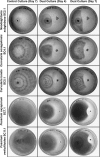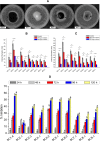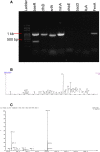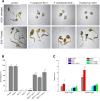Lipopeptide mediated biocontrol activity of endophytic Bacillus subtilis against fungal phytopathogens
- PMID: 30940070
- PMCID: PMC6444643
- DOI: 10.1186/s12866-019-1440-8
Lipopeptide mediated biocontrol activity of endophytic Bacillus subtilis against fungal phytopathogens
Abstract
Background: The use of chemical fungicides against fungal pathogens adversely affects soil and plant health thereby resulting in overall environmental hazards. Therefore, biological source for obtaining antifungal agents is considered as an environment-friendly alternative for controlling fungal pathogens.
Results: In this study, seven endophytic bacteria were isolated from sugarcane leaves and screened for its antifungal activity against 10 fungal isolates belonging to the genera Alternaria, Cochliobolus, Curvularia, Fusarium, Neodeightonia, Phomopsis and Saccharicola isolated from diseased leaves of sugarcane. Among the seven bacterial isolates, SCB-1 showed potent antagonistic activity against the tested fungi. Based on the phenotypic data, Fatty Acid Methyl Esters (FAME) and 16S rRNA gene sequence analysis, the isolate SCB-1 was identified as Bacillus subtilis. The bacterial isolate was screened negative for chitinase production; however, chloroform and methanol extracts of the bacterial culture caused significant inhibition in the growth of the fungal isolates on semisolid media. Volatile component assay showed highest inhibitory activity against Saccharicola bicolor (SC1.4). A PCR based study detected the presence of the genes involved in biosynthesis of surfactin, bacillaene, difficidin, macrolactins and fengycin. Mass spectrometric analysis of the bacterial extract detected the presence of antifungal lipopeptide surfactin, but other metabolites were not detected. The biocontrol activity of the bacterial isolate was established when bacterial pretreated mung bean seeds were able to resist Fusarium infection, however, the untreated seeds failed to germinate.
Conclusion: The antifungal potential of isolate Bacillus subtilis SCB-1 was established against taxonomically diverse fungal pathogens including the genera Saccharicola, Cochliobolus, Alternaria and Fusarium. The potent antifungal compound surfactin as well as volatiles produced by the bacterial isolate could be responsible for its bio-control activity against fungal infections.
Keywords: Antifungal activity; Bacillus subtilis; Biological control; FAME; LC-MS; Surfactin.
Conflict of interest statement
Ethics approval and consent to participate
No animals, human subjects, human material, or human data are used in this study.
Consent for publication
Not applicable.
Competing interests
The authors declare that they have no competing interests.
Publisher’s Note
Springer Nature remains neutral with regard to jurisdictional claims in published maps and institutional affiliations.
Figures




Similar articles
-
Characterization of fungal antagonistic bacilli isolated from aerial roots of banyan (Ficus benghalensis) using intact-cell MALDI-TOF mass spectrometry (ICMS).J Appl Microbiol. 2013 May;114(5):1300-10. doi: 10.1111/jam.12161. Epub 2013 Mar 1. J Appl Microbiol. 2013. PMID: 23387377
-
Stress-Responsive Alternative Sigma Factor SigB Plays a Positive Role in the Antifungal Proficiency of Bacillus subtilis.Appl Environ Microbiol. 2019 Apr 18;85(9):e00178-19. doi: 10.1128/AEM.00178-19. Print 2019 May 1. Appl Environ Microbiol. 2019. PMID: 30824454 Free PMC article.
-
Endophytic Bacillus spp. produce antifungal lipopeptides and induce host defence gene expression in maize.Microbiol Res. 2015 Mar;172:79-87. doi: 10.1016/j.micres.2014.11.004. Epub 2014 Nov 28. Microbiol Res. 2015. PMID: 25497916
-
Biological control of plant pathogens by Bacillus species.J Biotechnol. 2018 Nov 10;285:44-55. doi: 10.1016/j.jbiotec.2018.07.044. Epub 2018 Aug 30. J Biotechnol. 2018. PMID: 30172784 Review.
-
Ecological and mechanistic insights into the direct and indirect antimicrobial properties of Bacillus subtilis lipopeptides on plant pathogens.J Chem Ecol. 2013 Jul;39(7):869-78. doi: 10.1007/s10886-013-0319-7. Epub 2013 Jul 16. J Chem Ecol. 2013. PMID: 23888387 Review.
Cited by
-
Overcoming Encouragement of Dragon Fruit Plant (Hylocereus undatus) against Stem Brown Spot Disease Caused by Neoscytalidium dimidiatum Using Bacillus subtilis Combined with Sodium Bicarbonate.Plant Pathol J. 2021 Jun;37(3):205-214. doi: 10.5423/PPJ.OA.01.2021.0007. Epub 2021 Jun 1. Plant Pathol J. 2021. PMID: 34111911 Free PMC article.
-
Characterisation of Plant Growth-Promoting Endophytic Bacteria from Sugarcane and Their Antagonistic Activity against Fusarium moniliforme.Trop Life Sci Res. 2021 Sep;32(3):97-118. doi: 10.21315/tlsr2021.32.3.6. Epub 2021 Sep 30. Trop Life Sci Res. 2021. PMID: 35656370 Free PMC article.
-
Potentiality of Beneficial Microbe Bacillus siamensis GP-P8 for the Suppression of Anthracnose Pathogens and Pepper Plant Growth Promotion.Plant Pathol J. 2024 Aug;40(4):346-357. doi: 10.5423/PPJ.OA.01.2024.0022. Epub 2024 Aug 1. Plant Pathol J. 2024. PMID: 39117334 Free PMC article.
-
Acid tolerant bacterium Bacillus amyloliquefaciens MBNC retains biocontrol efficiency against fungal phytopathogens in low pH.Arch Microbiol. 2022 Jan 7;204(2):124. doi: 10.1007/s00203-021-02741-5. Arch Microbiol. 2022. PMID: 34997335
-
Diversity and Taxonomic Distribution of Endophytic Bacterial Community in the Rice Plant and Its Prospective.Int J Mol Sci. 2021 Sep 21;22(18):10165. doi: 10.3390/ijms221810165. Int J Mol Sci. 2021. PMID: 34576331 Free PMC article. Review.
References
-
- Bourke A. “The visitation of god?” the potato and the great Irish famine. Dublin: Lilliput Press Ltd; 1993.
-
- Fry WE, Goodwin SB. Resurgence of the Irish potato famine fungus. Bioscience. 1997;47:363–371. doi: 10.2307/1313151. - DOI
-
- Padmanabhan SY. The great Bengal famine. Annu Rev Phytopathol. 1973;11:11–24. doi: 10.1146/annurev.py.11.090173.000303. - DOI
MeSH terms
Substances
LinkOut - more resources
Full Text Sources
Miscellaneous

